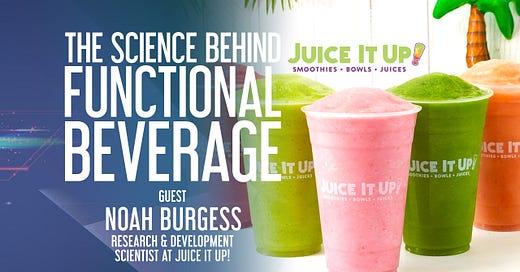The Science Behind Fast Casual's Functional Beverage Revolution
The functional beverage market is exploding, and fast-casual operators are taking notice. In a recent episode of Fast Casual Nation, hosts Paul Barron and Cherryh Cansler sat down with Noah Burgess, Research & Development Scientist at Juice It Up!, to explore how science-driven beverage innovation is reshaping the industry. With the functional beverage market valued at $243 billion in 2024 and projected to reach $463 billion by 2033, restaurant professionals can no longer afford to ignore this lucrative category.
Burgess, who joined Juice It Up! straight out of college as a food scientist, shared insights into the brand's approach to developing beverages that balance nutrition with flavor. "I always want my drinks not only to be healthy but flavor is super important," Burgess explained. "I don't want a guest to be like 'Oh this is a chore.' I want them to enjoy their healthy drink as well." This philosophy drives everything from their classic smoothies to their plant-based line, which delivers complete nutrition under 200 calories per 20-ounce serving while functioning as legitimate meal replacements through high fiber content.
The real revenue driver lies in customization and add-ons. Juice It Up! sees 35-45% of customers adding boosts to their beverages, from protein powders and collagen to immunity-supporting vitamin C shots. These additions not only enhance the functional benefits but significantly increase check averages – a critical consideration for operators looking to offset rising labor and ingredient costs. The brand offers eight different boost options that can be added to any beverage, creating countless personalization possibilities that today's consumers crave.
Understanding your demographic is crucial for success in this space. Gen Z customers, who drive much of the functional beverage demand, prioritize three key elements: vibrant colors for social media appeal, unique flavors that expand their palate, and energy-boosting ingredients. Burgess noted that incorporating elements like spirulina (for its striking blue color and B12 content) or exotic flavors like ube (purple sweet potato) resonates strongly with younger consumers who view these beverages as both nutrition and experience.
The development process combines consumer research with supplier innovation and rigorous nutritional guardrails. Burgess emphasized visiting small, independent juice bars near universities to spot emerging trends, then reverse-engineering popular concepts for profitable scalability. Every new product must meet strict criteria: no artificial colors or flavors, specific calorie targets based on intended use, and most importantly, exceptional taste that encourages repeat visits.
For fast-casual operators considering beverage expansion, the functional category offers compelling unit economics and customer loyalty benefits. With ingredients like red beets (for cardiovascular health and athletic performance) and collagen (for beauty benefits) gaining mainstream acceptance, the opportunity extends far beyond traditional smoothie concepts. As Burgess noted, success requires treating beverages not as afterthoughts but as carefully engineered products that deliver both genuine health benefits and operational profitability – a combination that's proving irresistible to both consumers and savvy restaurant operators.









